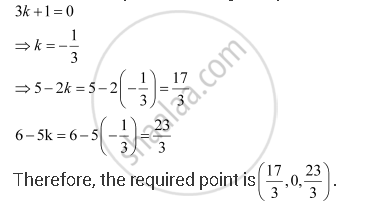Advertisements
Advertisements
Question
Find the coordinates of the point where the line through (5, 1, 6) and (3, 4, 1) crosses the ZX − plane.
Solution
It is known that the equation of the line passing through the points, (x1, y1, z1) and (x2, y2, z2), is

Any point on the line is of the form (5 − 2k, 3k + 1, 6 −5k).
Since the line passes through ZX-plane,

APPEARS IN
RELATED QUESTIONS
In following cases, determine the direction cosines of the normal to the plane and the distance from the origin.
z = 2
In following cases, determine the direction cosines of the normal to the plane and the distance from the origin.
5y + 8 = 0
Find the equation of the plane with intercept 3 on the y-axis and parallel to ZOX plane.
Find the coordinates of the point where the line through (5, 1, 6) and (3, 4, 1) crosses the YZ-plane
Find the coordinates of the point where the line through (3, −4, −5) and (2, − 3, 1) crosses the plane 2x + y + z = 7).
The planes: 2x − y + 4z = 5 and 5x − 2.5y + 10z = 6 are
(A) Perpendicular
(B) Parallel
(C) intersect y-axis
(C) passes through `(0,0,5/4)`
Find the coordinates of the point where the line through the points (3, - 4, - 5) and (2, - 3, 1), crosses the plane determined by the points (1, 2, 3), (4, 2,- 3) and (0, 4, 3)
Find the equation of the plane passing through the point (2, 3, 1), given that the direction ratios of the normal to the plane are proportional to 5, 3, 2.
Reduce the equation 2x − 3y − 6z = 14 to the normal form and, hence, find the length of the perpendicular from the origin to the plane. Also, find the direction cosines of the normal to the plane.
Reduce the equation \[\vec{r} \cdot \left( \hat{i} - 2 \hat{j} + 2 \hat{k} \right) + 6 = 0\] to normal form and, hence, find the length of the perpendicular from the origin to the plane.
Write the normal form of the equation of the plane 2x − 3y + 6z + 14 = 0.
The direction ratios of the perpendicular from the origin to a plane are 12, −3, 4 and the length of the perpendicular is 5. Find the equation of the plane.
Find the equation of a plane which is at a distance of \[3\sqrt{3}\] units from the origin and the normal to which is equally inclined to the coordinate axes.
Find the equation of the plane which contains the line of intersection of the planes \[x + 2y + 3z - 4 = 0 \text { and } 2x + y - z + 5 = 0\] and whose x-intercept is twice its z-intercept.
Prove that the line of section of the planes 5x + 2y − 4z + 2 = 0 and 2x + 8y + 2z − 1 = 0 is parallel to the plane 4x − 2y − 5z − 2 = 0.
Find the value of λ such that the line \[\frac{x - 2}{6} = \frac{y - 1}{\lambda} = \frac{z + 5}{- 4}\] is perpendicular to the plane 3x − y − 2z = 7.
Find the vector equation of the plane passing through the points (3, 4, 2) and (7, 0, 6) and perpendicular to the plane 2x − 5y − 15 = 0. Also, show that the plane thus obtained contains the line \[\vec{r} = \hat{i} + 3 \hat{j} - 2 \hat{k} + \lambda\left( \hat{i} - \hat{j} + \hat{k} \right) .\]
Write the plane \[\vec{r} \cdot \left( 2 \hat{i} + 3 \hat{j} - 6 \hat{k} \right) = 14\] in normal form.
Write a vector normal to the plane \[\vec{r} = l \vec{b} + m \vec{c} .\]
Write the value of k for which the line \[\frac{x - 1}{2} = \frac{y - 1}{3} = \frac{z - 1}{k}\] is perpendicular to the normal to the plane \[\vec{r} \cdot \left( 2 \hat{i} + 3 \hat{j} + 4 \hat{k} \right) = 4 .\]
Write the vector equation of the line passing through the point (1, −2, −3) and normal to the plane \[\vec{r} \cdot \left( 2 \hat{i} + \hat{j} + 2 \hat{k} \right) = 5 .\]
Find the vector equation of a plane which is at a distance of 5 units from the origin and its normal vector is \[2 \hat{i} - 3 \hat{j} + 6 \hat{k} \] .
The equation of the plane containing the two lines
The equation of the plane \[\vec{r} = \hat{i} - \hat{j} + \lambda\left( \hat{i} + \hat{j} + \hat{k} \right) + \mu\left( \hat{i} - 2 \hat{j} + 3 \hat{k} \right)\] in scalar product form is
The equations of x-axis in space are ______.
If the line drawn from the point (–2, – 1, – 3) meets a plane at right angle at the point (1, – 3, 3), find the equation of the plane.
The plane 2x – 3y + 6z – 11 = 0 makes an angle sin–1(α) with x-axis. The value of α is equal to ______.
Find the vector equation of a plane which is at a distance of 7 units from the origin and which is normal to the vector `3hati + 5hatj - 6hatk`
In the following cases find the c9ordinates of foot of perpendicular from the origin `2x + 3y + 4z - 12` = 0
